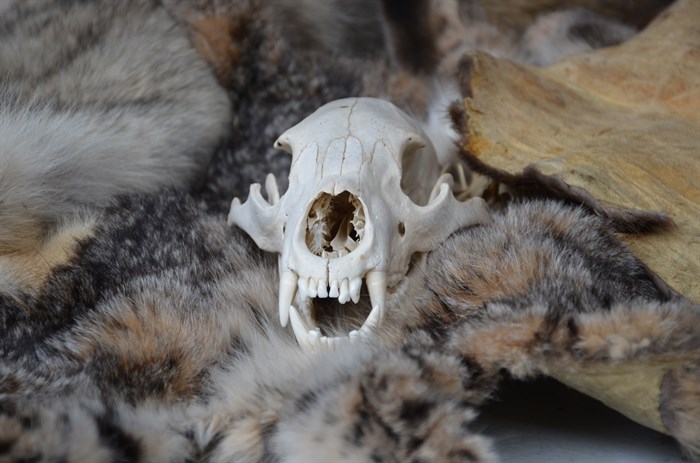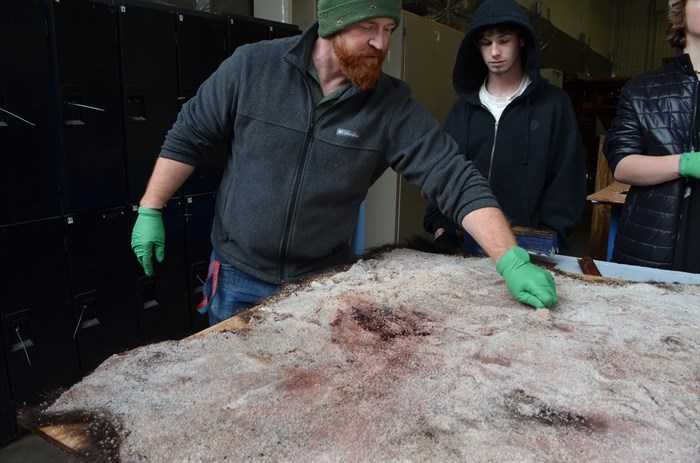
Multiple animal hides and carcasses were donated to Mount Boucherie High School from local hunters.
Image Credit: SUBMITTED/ Craig Arsenault
November 18, 2023 - 7:00 AM
Mount Boucherie High School in West Kelowna has added a new and unusual science course to its curriculum that will teach survival skills to students like tanning animal hides and and preserving food.
The course is called ‘Science for Citizens’ and offers grade 11 students an alternative to traditional physics, chemistry or biology classes.
Teacher Craig Arsenault developed the course at Mount Boucherie with a more hands-on, project-based approach in mind.
Part of the course is focused on environmental topics like evolution, natural selection, and land conservation. It also requires students to get their hands dirty with animal skins.
As a hunter himself, Arsenault said creating things out cow hides also provides students with a deeper understanding of food sources.

Craig Arsenault shows students the process of tanning and making leather.
Image Credit: SUBMITTED/ Craig Arsenault
“As a biologist, oftentimes people say, but you're a biologist, how could you be a hunter?” Arsenault said. “And the answer is that it brings you closer to the animals and the land that you're dealing with. It gives you a much firmer perspective on how things really are.”
Arsenault said he reached out to local hunters on Facebook to source animal hides for his classes. He was overwhelmed by the positive response.
“I got hundreds of replies,” he said. “We got tons of deer hides. We got a couple of rabbits. We got a full moose hide. A rancher up in Cherryville donated ten cow hides and has as many more as we want. So, yeah, we're fully stocked and can continue to run the program for years to come.”
So far, students have worked on fetching and salting three racoons, two deer, a bear and a sheep hide. Up next is the chemical tanning process where the skins will need to be first put in an acid bath, then a neutralising base and then the tanning formula.

A demonstration using a racoon skin at Mount Boucherie High School.
Image Credit: SUBMITTED/ Craig Arsenault
The finished products will then be donated to the Indigenous Education department and textiles program to make drums and beading. Nothing will go to waste.
“If we do the moose, we'll donate that to be a rug on the floor in the Indigenous Ed gathering room,” Arsenault said. “We can donate the leather. There's a medieval armoury program here at the school, so we can donate hides and leather to that.”
So far, Arsenault said, the student response has been overwhelmingly positive and there has been a very good attendance score to match.
“I have all kinds of fantastic responses. The kids jump in with both feet,” he said. “They're in there. They're scraping hides and getting a little schmucky. It's fantastic. They're very interested.”
For some though, the animal skins are a little too much. For them, Arsenault is sourcing beeswax and teaching students how to make natural candles.
Throughout the course development, Arsenault said he has been working closely with his Indigenous colleagues who have taken a couple of hides for separate classes.
“We’re absolutely trying to incorporate as much as we can,” he said. “There hasn’t been a lot of this in schools. I didn’t realize the support would be so big for it. But, (the Indigenous teachers are) very much involved step by step in the whole thing.”
The course consists of three other distinct units. One of the units, Scientific Literacy, gets students to dive into conspiracy theory analysis.
“We go over how to collect and look at data, how to make sure that you're not being deceived by data that other people are presenting to you,” Arsenault said.
Arsenault and his students did an analysis of flat earth theory and why, when presented with concrete data and evidence, believers remained unswayed. Students then chose their own conspiracy theories to break down and explore in individual projects.
Students also look at technology and food science, where they learn preservation techniques, like pickling, canning and jarring, smoking and salting of different foods.
Arsenault explained that the entire course is designed to make science applicable to the everyday citizen.
“(It’s) realizing that scientific processes aren't just mixing chemicals and doing formulas in a lab. It's real-world applications.”
— This story was updated at 11:48 a.m. Monday, Nov. 20, 2023, with new submitted photos.
To contact a reporter for this story, email Georgina Whitehouse or call 250-864-7494 or email the editor. You can also submit photos, videos or news tips to the newsroom and be entered to win a monthly prize draw.
We welcome your comments and opinions on our stories but play nice. We won't censor or delete comments unless they contain off-topic statements or links, unnecessary vulgarity, false facts, spam or obviously fake profiles. If you have any concerns about what you see in comments, email the editor in the link above. SUBSCRIBE to our awesome newsletter here.
News from © iNFOnews, 2023